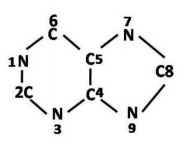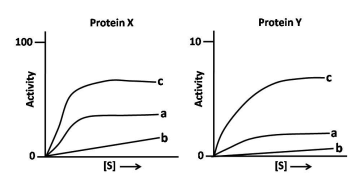 Multiple Choice Questions
Multiple Choice QuestionsFrom the following statements,
A. For a reaction to occur spontaneously the free energy change must be negative.
B. The interaction between two nitrogen molecules in the gaseous state is predominantly electrostatic.
C. By knowing bond energies, it is possible to deduce whether the bond is covalent bond or hydrogen bond.
D. Hydrophobic interactions are not important in a folded globular protein.
Pick the combination with ALL Wrong statements.
A and B
B and C
C and D
B and D
The following are four statements on peptide/ protein conformation:
A. Glycine has the largest area of conformational allowed space in the Ramachandran plot of φ and ψ.
B. A 20-residue peptide that is acetylated at the N-terminus and amidated at the C-terminus has φ = -60° (±5), ψ = -30° (±5) for all the residues. It can be concluded that conformation of the peptide is helix-turn-strand.
C. The allowed value of φ, ψ for amino acids in a protein are not valid for short peptides.
D. A peptide Acetyl-A1-A2-A3-A4-CONH2 (A1-A4 are amino acids) adopts a well-defined β-turn. The dihedral angles of A2 and A3 determine the type of β-turn.
Choose the combination of correct statements.
A and B
B and C
A and D
C and D
In the biosynthesis of purine:

All N atoms, C4 and C5 are from aspartic acid.
N1 is from aspartic acid; N3 and N9 are from glutamine side-chain; N7, C4 and C5 are from glycine.
N1 is from aspartic acid; N3 from glutamine side-chain; N9 from N attached to Cα of glutamine; N7, C4, and C5 are from glycine.
N1 is from glutamine; N3 from glutamine side-chain; N9 from attached to Cα of glutamine; N7, C4, and C5 are from glycine.
A researcher was investigating the substrate specificity of two different enzymes, X and Y, on the same substrate. Both the enzymes were subjected to treatment with either heat or an inhibitor of the enzyme activity. The following are the results obtained where a = inhibitor treatment, b = heat treatment, and c = control.

Which of the following statements is correct?
Only protein X is specific for the substrate, S
Only protein Y is specific for the substrate, S
Both X and Y are specific for the substrate, S
Both X and Y are non-specific for the substrate, S
Glycerol is added to protein solutions to stabilize the preparations by
increasing the viscosity of solution
stabilizing the pH
preferential hydration of proteins
interacting and neutralizing the surface charges on the proteins
Protein stability is represented as
Folded Unfolded
Prior to the development of sensitive calorimeters, thermodynamic parameters of processes were determined by the following equation
ln Keq =
are standard changes in enthalpy and entropy, respectively.
Which one of the following statements is correct for estimating ?
Determining the ratio of folded and unfolded protein at 37°C.
Plotting Keq as a function of H
Plotting Keq against S
Plotting Keq against temperature
The pH of a solution is 7.4 ± 0.02 where 0.02 is the standard deviation obtained from eight measurements. If more measurements were carried out, the % samples whose pH would fall between pH 7.38 and 7.42 is
99.6
95.4
68.2
99.8
Which one of the following modification of proteins is co-translational?
Palmitoylation
Myristoylation
Farnesylation
Addition of cholesterol
From the following statements:
A. In proteins, the amino acids that can undergo oxidation are Cys and Met.
B. A tetrasaccharide composed of alternate L and D isomers will not be optically active.
C. The G(Kcal/ mol) values for Keq of 0.1, 0.01 and 0.001 are 1.36, 2.72, and 4.09, respectively. It can be concluded that the relationship between G and Keq is parabolic.
D. The oxidation states of Fe in haemoglobin is +2. In cytochrome C, the oxidation states of Fe can be +2 or +3.
E. In DNA, the sugar and bases are planar.
F. High-energy bonds hydrolyze with large negative G.
Choose the combination with only one wrong statement.
A, E, F
B, C, D
C, D, E
A, B, C
Point group symmetry operations such as inversion and mirror plane are not applicable to protein crystals. This is because
protein molecules assemble in a highly ordered fashion.
protein molecules have handedness
protein molecules form a lattice plane that do not diffract X-rays.
hydrogen atoms in proteins diffract weakly.
